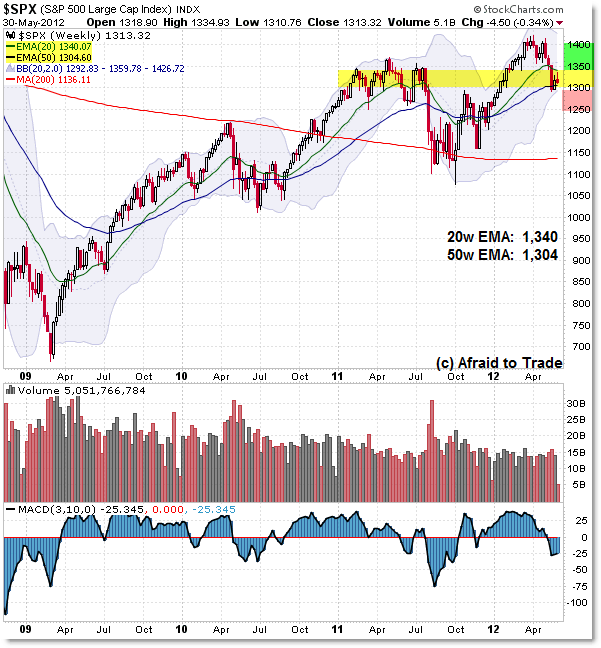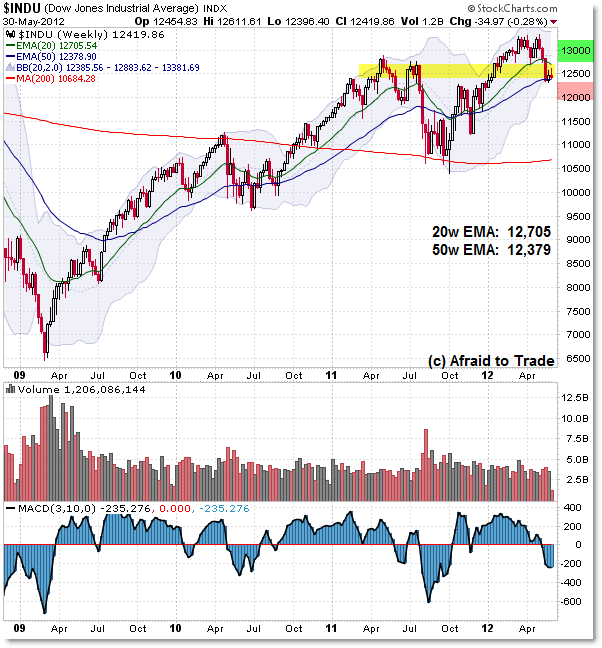Watching the Weekly EMA Stock Market Key Levels
It’s not common when the 20 and 50 week EMAs play a key role in providing both support/resistance as is the situation currently.
Let’s take a quick reference glance at the S&P 500, Dow Jones, and NASDAQ weekly charts to highlight these key EMA compression levels and what this means for the current structure.
First, the S&P 500:

While you can view the other indicators (momentum, Bollinger Bands, Volume), I’ll focus this update on the price compression between the 20 and 50 week EMAs in each index.
This will provide a key reference for you to use in your analysis to find additional confluence such as shorter-term Fibonacci levels, hand-drawn trendlines, and other important levels affecting price.
For the S&P 500, price is compressed between the key resistance confluence at 1,340 and the key support confluence at 1,300.
As if by magic (coincidence, actually)- these are the weekly EMA reference levels.
A breakthrough above 1,340 that carries beyond 1,350 would open the higher resistance target back to 1,400.
A breakdown under 1,300 strongly suggests 1,275 will be achieved quickly, if not lower.
Here is the Dow Jones:

We see a similar structural compression of price between the 20 week EMA (12,700 for easy reference) and the 50 week EMA (12,400).
The upper resistance – similar to the S&P 500 as well – stretches back to the mid-2011 price highs which are additional reference points presently.
A breakthrough above resistance allows a target to extend to 13,000 and beyond while a breakdown opens the door – or trap-door – for 12,000 or lower.
The NASDAQ is also compressed between its weekly EMAs:

For the NASDAQ, the weekly EMA index levels include 2,900 (easy reference) for the 20 week and 2,800 for the 50 week EMAs.
It’s almost certain that what happens – a breakthrough higher or a breakdown lower – to one index will occur to all, so visualize these structural levels as part of the broader picture.
Also, notice how the confluence of the rising 50 week EMA and the lower Bollinger Band provided support recently from which last week’s ‘oversold bounce’ rallies developed.
As the 50 week EMAs – and lower Bollingers – have been successful at supporting price (driving in buyers), it would be a significant development should these respective levels break (fail to support price) in the near future.
For additional detailed and timely analysis, join us in the Weekly (and Daily) Premium Membership reports.
Corey Rosenbloom, CMT
Afraid to Trade.com
Follow Corey on Twitter: http://twitter.com/afraidtotrade
Corey’s new book The Complete Trading Course (Wiley Finance) is now available!

I see a biiig H&S forming, lacking a right shoulder. Yet.
Find out what stock market experts have to say about NSE, BSE, MCX and NCDEX and also know nifty trend from market experts for free.
This graph has well explanation in it. Nice research indeed.